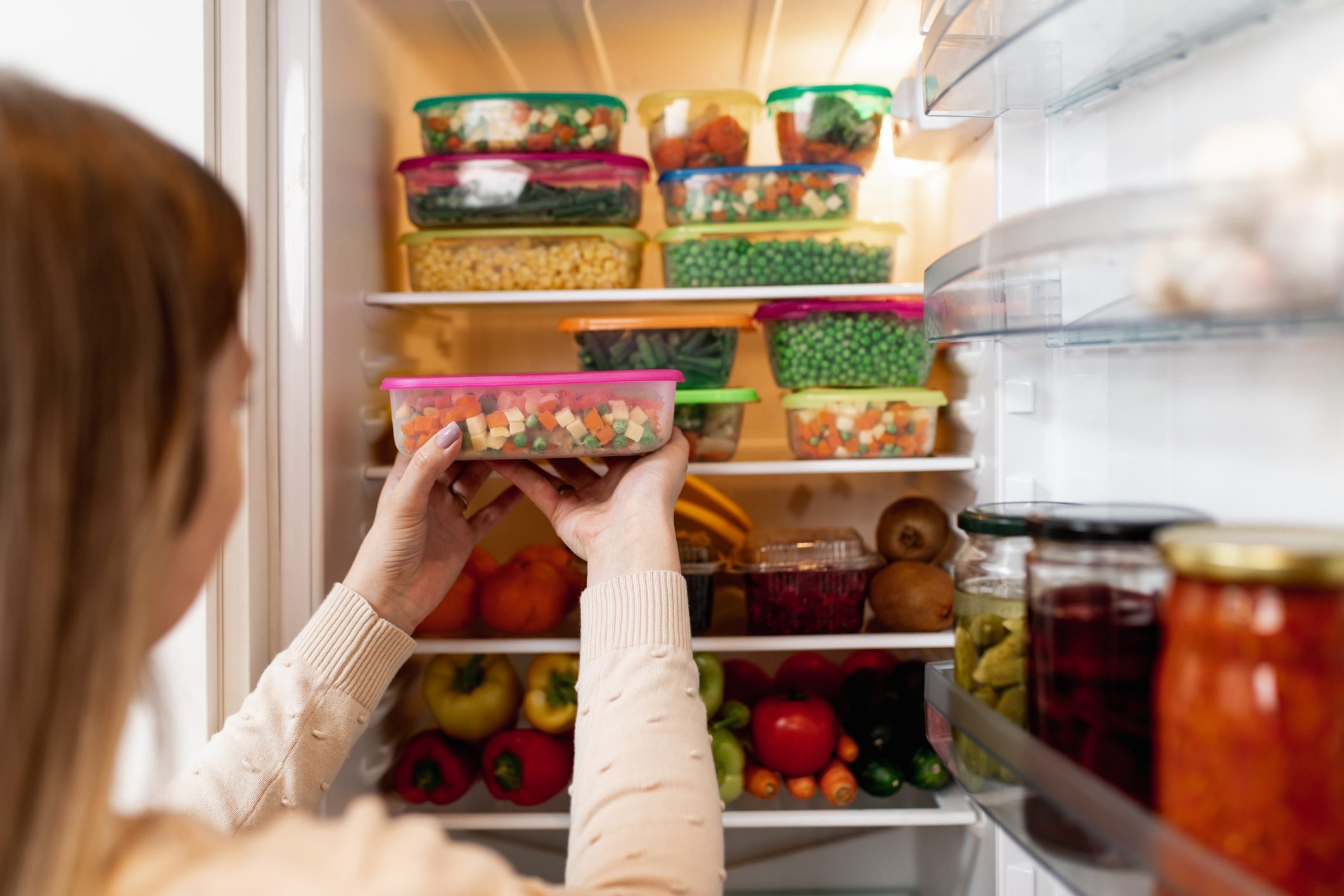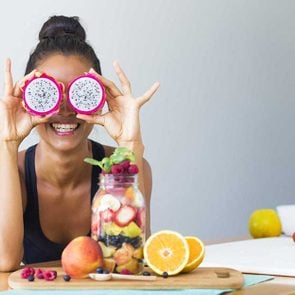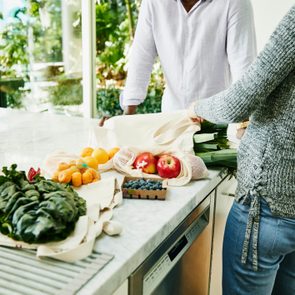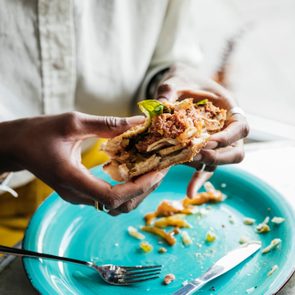5 Meal Prep Tips for People Who Are Vegans or Vegetarians
Updated: Jun. 10, 2021
When it comes to a plant-based diet, meal prep is key. You can eat nutrition-packed meals all week with these vegan and vegetarian meal prep tips, from stocking up on pantry staples to cooking food in advance.
Our editors and experts handpick every product we feature. We may earn a commission from your purchases.
Home cooking and meal prep
Put down the plant-based fast food. For real.
Even though ready-made vegan and vegetarian fast foods seem like healthier choices, they can be loaded with highly processed ingredients. Why not bang around a few pots and pans instead?
Home cooking is so powerful that preparing even one meal a day can improve the quality of your diet, according to a 2020 Public Health Nutrition study of over 8,000 people.
Of course, not everyone is a whiz in the kitchen—and that’s okay. If you’d like to cook more healthy vegetarian or vegan meals but have no clue where to begin, this five-step meal prep guide has you covered.
Vegan vs. vegetarian: What’s the difference?
First, before you begin meal prepping, it’s important to know there is a wide spectrum of plant-based diets. Of these, vegan eating tends to be the most strict, consisting entirely of plants and excluding all animal products.
If you’re a vegan, you’ll eat lots of fruits, vegetables, whole grains, nuts, and seeds. But you won’t eat any meat, poultry, seafood, dairy, or eggs—or any ingredients made from animals, like honey, collagen, or gelatin.
(Plant-based vs. vegan: here’s how these diets differ.)
By comparison, a vegetarian diet is more flexible. Like veganism, it consists mainly of plant foods, yet it allows some animal products. Unlike vegan diets, which are pretty much set in stone, the traditional meat-free vegetarian diet can be modified to fit your nutrition needs. All variations of the vegetarian diet exclude meat but may include certain animal products.
Here’s a quick guide:
- Ovo vegetarian: Allows eggs
- Lacto vegetarian: Contains dairy
- Lacto-ovo vegetarian: Permits eggs and dairy
- Pescatarian: Allows fish
Benefits of a plant-based diet
A plant-based diet is good for your body and for the earth. This antioxidant and fiber-rich eating pattern has been shown to protect against obesity, type 2 diabetes, high blood pressure, heart disease, and cancer.
Because growing plants uses fewer natural resources than raising livestock, it’s also more sustainable and kinder to the planet. (Here are more vegan diet health benefits.)
Like vegan diets, vegetarian diets are also linked to better weight management, and a lower risk of heart disease, type 2 diabetes, and cancer. Since they contain fewer animal products, they’re also a win for the environment. (Thinking of going vegetarian? Here’s are a few ways to get there.)

How to do vegan and vegetarian meal prep
Make a plan
Cooking is way easier when you have a game plan.
“I recommend taking inventory of your fridge and pantry to use up any ingredients you already have,” says Mackenzie Burgess, RDN, a registered dietitian nutritionist and recipe developer. “From there, plan out your recipes and grocery list to include a colorful variety of fruits, vegetables, whole grains, nuts, seeds, and lean protein.”
Round up a few recipe ideas
“Start with simple meals that you already love,” says Leanne Ray, a registered dietitian nutritionist and plant-forward recipe creator in Denver, Colorado. “A lot of times, people go too complicated and end up feeling overwhelmed, so try things like tacos, grain bowls, and soups.”
Emily Cooper, a registered dietitian nutritionist and author of The Easy Superfoods Cookbook begins with a favorite comfort food then swaps ingredients until the meal is healthier and meat free.
“My favorite ways to make vegan and vegetarian recipes easy and exciting is to take classic recipes that contain meat, and simply swap in plant-based ingredients,” she explains. “I’ve made a vegan cheesesteak by swapping out beef for tofu and mushrooms, and the cheese in the cheese sauce for a sweet potato–based alternative.”
The trick is to find plant-based ingredients with a similar texture or flavor to the animal foods a dish originally uses.
Or simply skip the meat in a dish that already includes beans, like chili, she suggests.
Vegetarian and vegan recipe ideas:
- Vegan recipes for breakfast, lunch, and dinner
- Better-than-takeout vegan dinner recipes
- Vegan comfort food recipes
- Tasty meatless meals
- Best vegetarian recipes of 2020
Head to the supermarket
A thoughtfully stocked kitchen means you won’t have to run out to the store for key ingredients at the last minute, says Cooper.
Load up on the following refrigerator staples:
Proteins
Produce
- Fruits
- Vegetables
- Fresh herbs
Flavor enhancers
- Nutritional yeast
- Coconut aminos
- Miso paste
- Soy sauce
Freezer staples
- Frozen fruit, like berries, mangos, papaya, and pineapple
- Frozen veggies, like broccoli, carrots, peas, corn, mixed veggies, diced onions, and chopped spinach
- Frozen riced cauliflower
- Frozen edamame
- Frozen minced garlic and ginger
Pantry staples
- Nuts and nut butters
- Seeds such as chia, flax, hemp, sunflower, sesame, and pumpkin
- Dry-roasted soybeans
- Dry and canned beans, chickpeas, and lentils (extra points for no-salt-added varieties)
- Whole grains like brown rice, quinoa, barley, farro, polenta, and oats
- Whole-wheat pasta
- Vegetable broth
- Canned tomatoes, tomato paste, and tomato sauce
- Dried herbs and spices
- Cooking oils (think olive, avocado, and canola for the healthiest fats)
- Canned light coconut milk
- Popcorn kernels
- Shelf-stable plant-based milks like oat, almond, soy, and cashew (refrigerate after opening)
Get the right kitchen gear
Whether you’re just getting started or have been cooking for years, these tools can make plant-based cooking a lot easier:
The basics
- Mixing bowls
- Measuring cups and spoons
- Heat-proof rubber spatula
- Cutting board
- A good set of knives
- A basic set of pots and pans
- Dutch oven. “It heats evenly and can easily move from stove top to oven,” says Ray. “It’s also great for making homemade bread.”
- Sheet pan (for roasting veggies, chickpeas, and tofu)
- Food processor. In addition to chopping, slicing, and dicing, it’s genius for whipping up homemade falafel, creamy hummus, or cashew queso, says Burgess.
- Reusable glass storage containers
- Mason jars. “So handy for freezing leftover sauces, storing pantry goods, or creating layered jar salads,” says Burgess.
The extras
- Zester
- Spiralizer
- Tofu press. “While a plate, towel, and heavy pan can get the job done, a tofu press is super effective for getting all of the excess water out, making more room for flavorings and marinades,” explains Cooper.
- Mandoline. Ray’s go-to for thinly slicing cabbage for slaws, potatoes for homemade baked chips, or radishes for salads.
- Dehydrator. “Dehydrated fruits and veggies make great snacks when you’re craving something crunchy,” says Cooper. “Making them yourself is a lot more cost-effective, too.”
- Multicooker. “Ideal for set-and-forget weeknight meals, batch cooking dried beans or whole grains, and for making soups and curries in record time,” says Ray.
- Cheesecloth. “Not just for cheese,” says Cooper. “A cheesecloth is great to have on hand for straining yogurt, or even making your own almond or nut milks.”
- Immersion blender (for pureeing soups and sauces, and making smoothies)
- Air fryer. “When you need dinner on the table ASAP, this time-saver can help you crank out crispy roasted veggies in no time,” says Cooper.
(Check out these 10 healthy vegan snacks you’ll actually want to eat.)
Try these nutritionist-approved tricks
Organize your ingredients ahead of time
“Have a bin or area in your cabinet, pantry, and refrigerator dedicated to that night’s dinner,” suggests Cooper. Then, fill it with the ingredients you’ll need so you won’t have to search for them when it’s prep time.
Batch cook
“Prepping whole grains like brown rice or quinoa, cooking dried beans, baking tofu, and chopping up your favorite vegetables over the weekend is a chore that your future work-week self will thank you for,” says Cooper.
Get creative with beans
“Try adding roasted chickpeas to Mediterranean couscous bowls, mash black beans into homemade veggie burgers, or sprinkle edamame over salads,” says Burgess.
Give grains new life
Cooked whole grains like quinoa, brown rice, and farro freeze beautifully. Cook them in bulk and freeze in single-serve containers to defrost for a quick side dish or to toss into soups, salads, or chili.
Lean on frozen produce
“Frozen fruits and vegetables are a game changer,” says Burgess. “They’re harvested at peak ripeness then flash frozen, locking in all their important nutrients. Plus, they’re pre-cut, saving you time in the kitchen.”
Give leftovers some love
Pack them in individual containers and pop them in the freezer to heat up at the end of a busy day.
Want to squeeze even more nutrition out of your meals? Try these healthy meal prep hacks.












